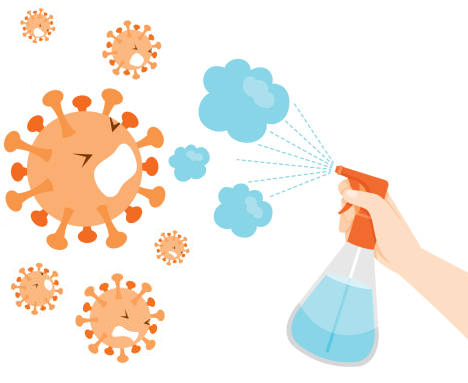Disinfectants & sanitizers keep your family healthy & safe
Disinfectants and sanitizers work to combat the spread of germs in the home and other settings. Disinfectants destroy microorganisms on surfaces, while sanitizers reduce the level of microorganisms present by significant numbers or to acceptable levels established by federal or provincial health authorities.
Opportunities for the transmission of infectious disease in our society are widespread. Although often spread by person-to-person contact, the bacteria and viruses that cause infectious disease can also survive for long periods of time on hard surfaces such as tables, counters, handles, faucets, sinks, telephones, keyboards and toilet areas. These surfaces provide reservoirs from which contamination spreads to susceptible individuals who touch these surfaces and then infect themselves by touching their eyes or nose or through ingestion.
The following are some examples of diseases and infections that are readily spread via environmental surfaces:

Common Cold
- The average adult gets about one to three colds per year, most often during the winter. Infants can get up to eight in a year because their body’s defences aren’t yet developed. Preschool children average five to seven cold episodes each year.
- It is estimated that 40% of time lost from work and 30% of school absences are due to the common cold.
Diarrhea
- Rotavirus, which is the cause of a large percentage of debilitating diarrheal infections, spread in and through day care centres, can remain viable on non-porous surfaces (toys, telephones, play tables, etc.) for up to 10 days.
- Children are known to put hands and objects in their mouths every 2-3 minutes, enhancing spread of the virus once it reaches toys.
From the Journal of Clinical Microbiology and the Journal of Hygiene (online at the Pubmed Database of the National Center for Biotechnology Information, National Library of Medicine, National Institutes of Health)
Food-borne Disease
- Food is often contaminated by contact with contaminated utensils, countertops and other kitchen surfaces.
- Even relatively low levels of contamination on kitchen surfaces can present a hazard.
- The salmonella organism survives on non-porous kitchen surfaces for up to 24 hours and on clean cloths for up to 48 hours.
From The Lancet (online at the Pubmed Database of the National Center for Biotechnology Information, National Library of Medicine, National Institutes of Health) and the Journal of Environmental Health
Hepatitis A
- Hepatitis A virus attacks the liver and is an important cause of morbidity and occasional mortality.
- Symptoms develop infrequently in children, which enhances the communicability of hepatitis A into the family from schools, day care centres, restaurants and health care facilities.
- Clinical studies show the hepatitis A virus survives on inanimate surfaces and human hands and can be transmitted from surfaces to humans via this route.
From the New England Journal of Medicine, the Journal of Clinical Microbiology and the Journal of Clinical Microbiology (online at the Publiced Database of the National Center for Biotechnology Information, National Library of Medicine, National Institutes of Health)
Learn more about disinfectants and sanitizers
How disinfectants and sanitizers are regulated in Canada
Disinfectants
Health Canada’s Natural and Non-prescription Health Products Directorate (NNHPD) is the federal regulatory authority that regulates disinfectants and disinfectant-sanitizers intended for use on non-critical medical devices. Before these products can be sold to consumers, the manufacturer must present scientific evidence of the product’s safety, efficacy and quality as required by the Food and Drugs Act and Food and Drug Regulations. To determine whether a product is a registered disinfectant/disinfectant-sanitizer, look for a Drug Identification Number (DIN) on the product label.
Ingredients in disinfectant products are regulated under the Canadian Environmental Protection Act, 1999 (CEPA) by Environment Canada and Health Canada. CEPA is “An Act respecting pollution prevention and the protection of the environment and human health in order to contribute to sustainable development.”
This link describes how processes under CEPA scientifically consider, in a comprehensive way, chemicals that are used in Canada and how they are managed to protect the health of Canadians and their environment. On December 8, 2006, the government announced a comprehensive plan for chemicals. This program has been world leading, with the third phase almost complete. For more information on this process, go to this excellent website: Chemical Substances. Under CEPA, the New Substances Notification Regulations ensure that all new ingredients (substances) are assessed for their potential to harm human health or the environment. These regulations are also applied to new substances used in products regulated under the Food and Drugs Act.
The Consumer Chemicals and Containers Regulations, 2001 and Hazardous Products Regulations regulate the way disinfectants and disinfectant-sanitizer products are packaged and labelled.
Sanitizers
Sanitizers are regulated as pest control products and approved under the Pest Control Products Act and Pest Control Product Regulations, which are administered by the Pest Management Regulatory Agency (PMRA). In order for a manufacturer to register a sanitizer product at the PMRA, the manufacturer must submit a full registration package for evaluation and approval. As part of this package, scientific data to support the registration is required. Based on this data, the PMRA will evaluate the effectiveness of the product and the potential for adverse impact on human health and the natural environment. To determine whether a product is a registered sanitizer, look for a Pest Control Product (PCP) number on the product label.
For information on how to safely and effectively clean and disinfect your home, please visit our Rethink Cleaning webpage.
